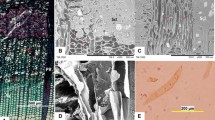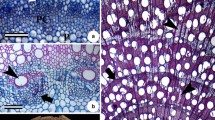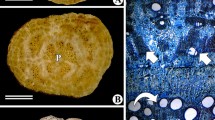Summary
Anatomical differences in xylem between the upper and lower sides formed in the inclined stems of Buxus microphylla with different angular displacement from the vertical were examined microscopically. B. microphylla exhibited a pronounced growth promotion on the lower side of the inclined stems. Formation of tension wood (gelatinous fibers) was not observed. Xylem formed on the lower side showed some interesting features resembling the compression wood formed in gymnosperms. The reaction wood tracheids and vessels showed an excessive lignification in their secondary walls but lacked both helical cavities and an S3 layer, features that were almost the same as those of primitive gymnosperms. These results indicate that B. microphylla has an ability to form compression wood, suggesting that in the genus Buxus a different mechanism in the conducting elements was developed in the phylogenetic evolution.
Similar content being viewed by others
References
Carlquist, S. 1982: Wood anatomy of Buxaceae: correlations with ecology and phylogeny. Flora 172:463–491
Côte, W. A.; Day, A. C.; Kutscha, N. P.; Timell, T. E. 1967: Studies on compression wood. V. Nature of compression wood formed in the early spring wood of conifers. Holzforschung 21:180–186
Fujita, M.; Saiki, H.; Sakamoto, J.; Araki, N.; Harada, H. 1979: The secondary wall formation of compression wood tracheids. IV. Cell wall structure of transitional tracheids between normal and compression wood. Bull. Kyoto Univ. For. 51:247–256
Höster, H.-R. 1966: Über das Vorkommen von Reaktionsgewebe in Wurzeln und Ästen der Dikotyledonen. Ber. Deutsch Bot. Ges. 79:211–212
Höster, H.-R.; Liese, W. 1966: Über das Vorkommen von Reaktionsgewebe in Wurzeln und Ästen der Dikotyledonen. Holzforschung 37:1–10
IAWA Committee 1964: Multilingual grossary of terms used in wood anatomy. Zürich
Kucera, L. J.; Philipson, W. R. 1977: Growth eccentricity and reaction anatomy in branchwood of Drimis winteri and five native New Zealand trees. New Zealand J. Bot. 15:517–524
Kucera, L. J.; Philipson, W. R. 1978: Growth eccentricity and reaction anatomy in branchwood of Pseudowintera colorata. Amer. J. Bot. 65:601–607
Meylan, B. A. 1981: Reaction wood in Pseudowintera colorata — A vessel-less dicotyledon. Wood Sci. Technol. 15:81–92
Nečesaný, V. 1955: Výskyt reakčniho dřeva s hlediska taxonomického. Sborník Vysoké Skoly Zemědělské a Lesnické Fakulty v Brně 3:131–149
Nečesaný, V.; Oberländerová, A. 1967: The analysis of causes of different formation of reaction wood in gymnosperms and angiosperms. Drev. Výskum 12 (2): 61–69
Onaka, F. 1949: Studies on compression- and tension-wood. Mokuzai Kenkyu 1:1–88
Timell, T. E. 1978a: Helical thickenings and helical cavities in normal and compression woods of Taxus baccata. Wood Sci. Technol. 12:1–15
Timell, T. E. 1978b: Ultrastructure of compression wood in Ginkgo biloba. Wood Sci. Technol. 12:89–103
Timell, T. E. 1979: Formation of compression wood in balsam fir (Abics balsamea). II. Ultrastructure of the differentiating xylem. Holzforschung 33:181–191
Timell, T. E. 1983: Origin and evolution of compression wood. Holzforschung 37:1–10
Timell, T. E. 1986: Compression wood in gymnosperms. Vol. I, pp. 257–259, pp. 597–621, Vol. II, pp. 934–943. Berlin: Springer-Verlag
Westing, A. G. 1965: Formation and function of compression wood in gymnosperms. Bot. Rev. 31:381–480
Yoshizawa, N.; Itoh, X; Shimaji, K. 1982: Variation in features of compression wood among gymnosperms. Bull. Utsunomiya Univ. For. 18:45–64
Yoshizawa, N.; Koike, S.; Idei, T. 1985a: Formation and structure of compression wood induced by repeated inclination in Taxus cuspidata. Mokuzai Gakkaishi 31:325–333
Yoshizawa, N.; Itoh, T.; Shimaji, K. 1985b: Helical thickenings in normal and compression wood of some softwoods. IAWA Bull. n.s. 6:131–138
Yoshizawa, N.; Idei, T. 1987: Some structural and evolutionary aspects of compression wood. Wood Fiber Sci. 19:343–352
Yoshizawa, N. 1987: Cambial responses to the stimulus of inclination and structural variations of compression wood tracheids in gymnosperms. Bull. Utsunomiya Univ. For. 23:23–141
Yumoto, M.; Ishida, S.; Fukazawa, K. 1982: Studies on the formation and structure of the compression wood cells induced by artificial inclination in young trees of Picea glauca. II. Transition from normal to compression wood revealed by a SEM-UVM combination method. J. Fac. Agr. Hokkaido Univ. 60:312–335
Author information
Authors and Affiliations
Additional information
The first author would like to express his sincere thanks to Dr. T. E. Timell, College of Environmental Science and Forestry, State University of New York, Syracuse, New York, for his invaluable suggestions in connection with this research
Rights and permissions
About this article
Cite this article
Yoshizawa, N., Satoh, M., Yokota, S. et al. Formation and structure of reaction wood in Buxus microphylla var. insularis Nakai. Wood Sci.Technol. 27, 1–10 (1992). https://doi.org/10.1007/BF00203405
Received:
Issue Date:
DOI: https://doi.org/10.1007/BF00203405




